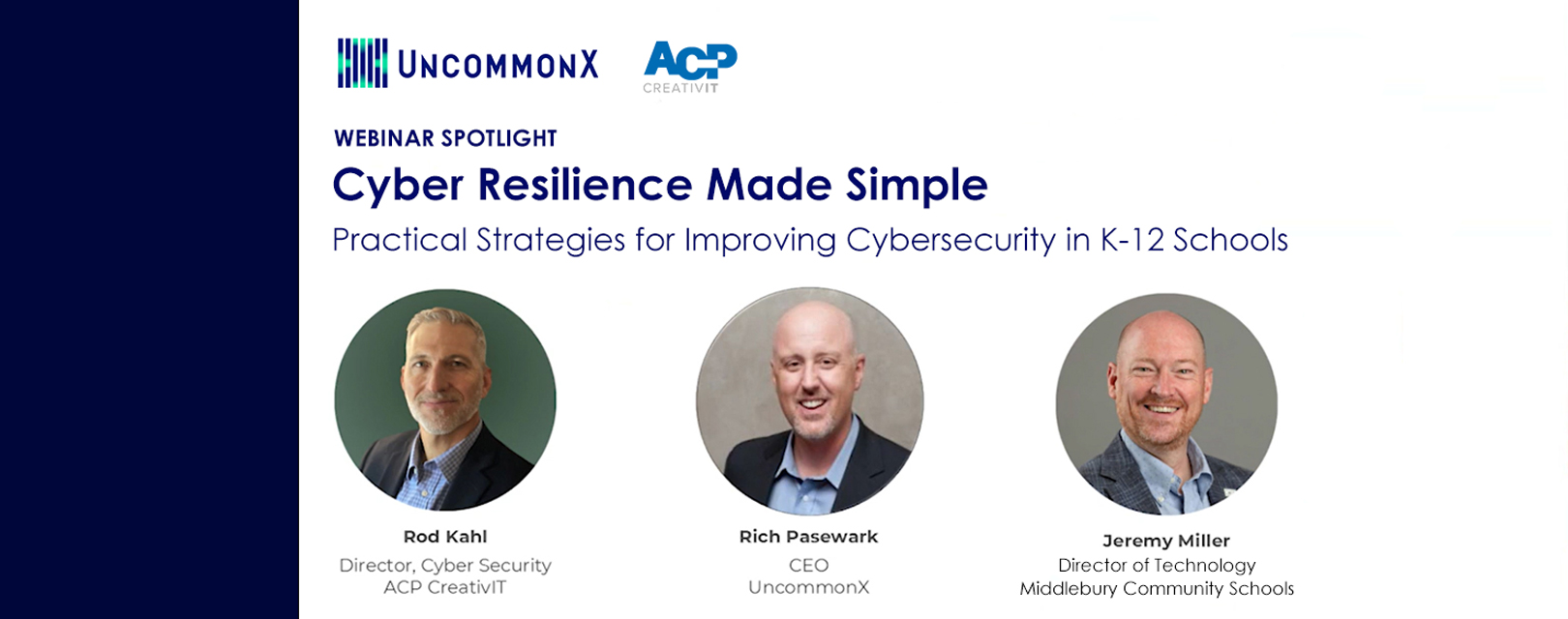Fortifying K-12 Cyber Defenses During Spring Break
As the spring break approaches, it's crucial for K-12 school district IT and security teams to be on high alert. The tranquility of deserted campuses...
Experiencing an active breach? Call us immediately at 1-866-405-9156 UncommonX has experienced ZERO reportable breaches.
4 min read
 Rich Pasewark - CEO, Board Director
:
May 10, 2024 8:00:00 AM
Rich Pasewark - CEO, Board Director
:
May 10, 2024 8:00:00 AM

The cybersecurity landscape in K-12 schools has reached a pivotal point. Despite growing threats, many schools find themselves underprepared, with a significant gap in both resources and readiness to effectively combat cyberattacks.
Our recent webinar hosted in partnership with ACP CreativIT brought together industry experts to discuss practical strategies to address these challenges and strengthen school district cyber resilience.
This blog post summarizes the discussion, which featured UncommonX CEO Rich Pasewark, ACP CreativIT Cyber Specialist Rod Kahl and Middlebury Community Schools Director of Technology Jeremy Miller. It also includes recommended actions schools can take today to begin bolstering their cyber posture and resiliency.
The Growing Imperative for Cybersecurity in Schools
Recent initiatives by the U.S. Department of Education and the Federal Communications Commission's proposal for a $200 million cybersecurity pilot program highlight the critical need for improved cyber resilience.
However, according to the May 2023 CoSN State of EdTech Leadership report, while cybersecurity remains a top priority for the fifth consecutive year, an alarming 66 percent of school districts do not have a full-time cybersecurity position.
This statistic becomes even more concerning in light of the Government Accountability Office's report, while cybersecurity remains a top priority for the fifth consecutive year, an alarming 66 percent of school districts do not have a full-time cybersecurity position.
Key Takeaways from the Webinar
"There’s never a good time to start [improving cybersecurity], but the worst time to start is when you have an incident happening."
— Richard Pasewark, CEO, UncommonX
Funding remains a significant barrier, with more than one in five districts having no designated funds for cybersecurity defense. This issue is exacerbated by an overarching underfunding crisis, as K-12 schools in the U.S. face an estimated annual shortfall of $150 billion. Our webinar panel emphasized the critical nature of securing more funding and strategic allocation to not only address immediate cybersecurity needs, but also to build long-term resilience.
The webinar participants stressed the importance of communicating the return on investment (ROI) for cybersecurity measures. With school downtime from attacks costing billions—as highlighted by a 2022 U.S. Government Accountability Office report stating downtime costs could exceed $9 billion when including colleges—investing in cybersecurity is not only preventative but also economically measurable.
Effective ROI communication can facilitate stakeholder buy-in by demonstrating that the cost of prevention pales in comparison to the expenses associated with recovering from cyber incidents. We can customize an ROI calculator to help build an effective business case for your needs. Connect with us at hello@uncommonx.com.
Practical strategies discussed included:
Jeremy Miller's recount of Middlebury Community Schools' ransomware recovery underscores the necessity of a proactive and well-prepared approach, emphasizing that the recovery from such attacks can disrupt educational processes for months.
“We woke up Christmas Eve morning in 2019 to a ransomware attack—the Ryuk strain. And they probably sat there for a while—UncommonX suggested up to a month—trying to gather as much information as they could. It was catastrophic.”
— Jeremy Miller, Director of Technology, Middlebury Community Schools
Detailed Best Practices and Solutions
Internal Best Practices:
|
|
| |
Ensure Multi-Factor Authentication (MFA): As a foundational security measure, MFA should be mandatory across all user accounts, particularly those accessing sensitive data. Schools should address any resistance by educating staff on the benefits of MFA and providing alternatives like hardware tokens for those who prefer not to use personal devices. |
 |
Update Incident Response Plans: Regularly review and update incident response strategies to reflect the current cyber threat landscape and changes in school infrastructure. This includes defining clear roles and responsibilities and ensuring all staff are trained on their roles during a cybersecurity incident. |
 |
Schedule a Security Audit: Conduct comprehensive security audits bi-annually to assess the effectiveness of existing security measures, and identify vulnerabilities. Use the insights gained to fortify defenses and prioritize areas needing attention. |
 |
Check all Data Backups: Regularly verify the integrity of backups and ensure they are performed consistently and stored securely. These backups are crucial for restoring operations quickly following a cyber incident. |
| |
Reinforce Network Security: Continuously monitor and upgrade network security measures. This includes using advanced firewall configurations, intrusion detection systems, and securing Wi-Fi networks against unauthorized access. |
External MDR Solutions:
|
|
 |
Real-Time Alerting: Implement systems that provide real-time alerts on potential security threats, allowing for immediate response and mitigation. This reduces the window of opportunity for attackers to cause significant damage. |
 |
Investigation, Triage, and Containment: Leverage external cybersecurity expertise to conduct thorough investigations of security incidents, followed by effective triage and containment of threats. This helps minimize the impact and scope of an attack. |
 |
Remediation in Concert with IT/MSP:Work closely with Managed Service Providers (MSPs) or internal IT teams to implement remediation strategies swiftly. This collaboration ensures that recovery is handled efficiently and system vulnerabilities are addressed promptly. |
 |
Monthly Reporting & Review: Regular reports and reviews are crucial to understand ongoing threats and the effectiveness of current security measures. This allows for continuous improvement and adjustment of strategies based on real-world results. |
 |
Vulnerability Management: Use external resources to continuously scan for and address vulnerabilities within the school’s digital infrastructure. This proactive approach helps prevent exploits and secure potential breach points before they can be attacked. |
 |
Broad Integrations; Rapid Deployment: Ensure that cybersecurity solutions integrate seamlessly with existing school IT systems and can be deployed quickly to respond to emerging threats. This integration enhances the overall security posture by allowing for a unified defense strategy. |
Schedule Your Free 30 Minute Consult
Book your free 30 minute block of time with one of our cybersecurity experts. We'll sit with you and your team to go through a simple cyber assessment rubric so you'll know your maturity score against the NIST framework, and where you stand with each component.
Taking the Next Step
Along with illuminating the growing cyber risk facing K-12 schools, the webinar highlighted small steps institutions can take to put their districts on a path to improving cyber resilience. As the landscape of digital threats evolves, the need for schools to advance their cybersecurity measures becomes increasingly urgent. By fostering a culture of proactive cyber resilience and securing the necessary resources, schools can protect their communities and ensure that education remains uninterrupted in the face of cyber threats.
The commitment of UncommonX and ACP CreativIT to safeguarding educational institutions remains unwavering. Explore our MDR for Education solution or reach out to hello@uncommonx.com

As the spring break approaches, it's crucial for K-12 school district IT and security teams to be on high alert. The tranquility of deserted campuses...

As the 2023/24 school year draws to a close, many districts are taking stock of the surge in cyber attacks that targeted educational institutions...

In early 2024 the Federal Communications Commision (FCC) advanced its proposalto launch a pilot program that would allocate $200 million for...